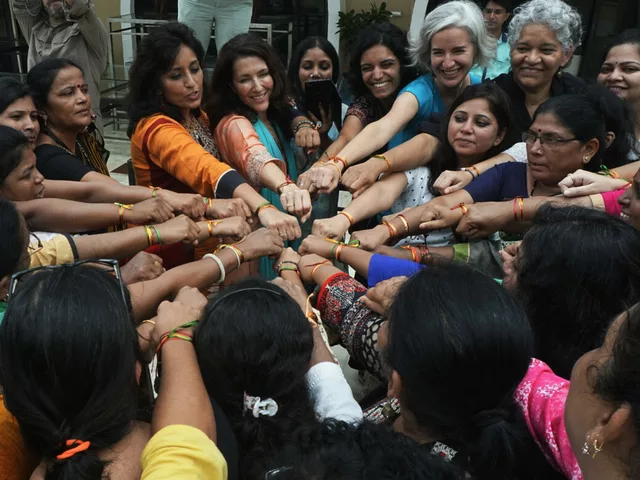Exploring the Unique Cultural Wonders of India: A Comparison to the U.S.
India is a unique and vibrant country with an incredibly rich and diverse culture. From the bustling streets of Delhi to the tranquil beauty of the Taj Mahal, India offers a wealth of cultural experiences that can’t be found anywhere else. As a result, living in India offers a variety of advantages over living in the U.S.One of the biggest advantages of living in India is that its culture provides a much more immersive experience than any other place in the world. In India, there are endless opportunities to explore the country’s ancient history, fascinating religions, and vibrant music and art. From the grand palaces of Rajasthan to the historic architecture of Lucknow, India’s cultural heritage is truly incomparable.
In addition to its deep cultural roots, India also offers a unique mix of modern and traditional lifestyles. From the expansive metropolises of Mumbai and Delhi to the rural villages of the Himalayan foothills, India’s diversity is on full display. Whether you choose to live in a bustling city or a peaceful village, India has something for everyone.
Lastly, living in India offers a unique opportunity to experience the warmth and hospitality of the Indian people. From the welcoming smiles of the locals to the delicious food served in local eateries, India’s culture is one of the most welcoming in the world.
Ultimately, living in India offers a variety of advantages over living in the U.S. From its immersive cultural experiences to its unique mix of modern and traditional lifestyles, India is a place unlike any other. So if you’re looking for an unforgettable adventure, India is the perfect place to start.
Saving Money: The Benefits of Living in India Versus Living in the U.S.
When comparing the cost of living in India and the United States, there is a stark difference. India is an incredibly affordable country to live in, with a wide range of prices depending on where you choose to live. In contrast, the U.S. is a much more expensive destination, with higher costs of housing, food and transportation.If you’re looking to save money and get more bang for your buck, India is the right country for you. Here are some of the ways in which you can save money while living in India:
• Housing: Renting an apartment in India is much more affordable than in the U.S. In major cities like Mumbai or Delhi, one bedroom apartments can be rented for as little as $100-$200 per month. Additionally, many landlords do not require security deposits or long-term leases, making it easier for renters to move around without having to pay extra fees.
• Food: Eating out in India is incredibly affordable, with prices for a full meal ranging from $2-$5. Home-cooked meals are even cheaper, with the ingredients for basic dishes costing just a few cents.
• Transportation: Public transportation in India is both affordable and convenient. For instance, a train ticket from Mumbai to Delhi can cost as little as $20. Buses, taxis and rickshaws are also incredibly affordable, making it easy to get around the country.
Overall, living in India is much more affordable than living in the U.S., with the potential to save a lot of money. Whether you’re looking to save up for travel or just want to enjoy a more cost-effective lifestyle, India is the perfect destination.
The Pros and Cons of Healthcare in India and the U.S.
When it comes to healthcare, there are advantages and disadvantages to living in both India and the United States. In India, healthcare is much more affordable than it is in the U.S. In general, medical care in India is much cheaper and more accessible than it is in the United States. Additionally, the Indian healthcare system offers a wider variety of low-cost treatments and preventative care for its citizens.On the other hand, the quality and availability of healthcare in the United States is much higher than it is in India. In the U.S., there is a greater emphasis on preventative care, and the overall standards of care are much higher than in India. Additionally, many of the newest treatments and medications are available in the U.S. but not in India.
In conclusion, both India and the United States have advantages and disadvantages when it comes to healthcare. Depending on your individual needs and budget, you may find one country better suited to your needs than the other. Ultimately, it is up to you to decide which country best meets your needs.
A Comparison of Education Systems: India Versus the U.S.
India and the United States are both countries that provide access to high-quality education and offer a range of educational opportunities for their citizens. However, there are some key differences between the education systems in India and the United States that prospective students should consider when trying to decide which country to live in.In India, the education system is highly centralized, meaning that the government has a great deal of control over the type and quality of education that is offered. The government also sets the standards for admission to universities and other higher educational institutions. This means that the quality of education is more consistent across India. However, the government also has tighter control over the curriculum and there is less flexibility for students to choose their own courses.
In the United States, the education system is more decentralized, meaning that each state has more control over the type and quality of education available. This means that there is more flexibility for students to choose their own courses and the quality of education can vary from state to state. However, admission to universities and other higher educational institutions is more competitive and there are more requirements that must be met.
From a financial standpoint, students in India have more access to government-funded scholarships and grants. This means that they can often get a quality education at a lower cost than students in the United States. In addition, the cost of living in India is generally lower than in the United States, making it easier for students to afford their education.
Overall, each country has its own advantages and disadvantages when it comes to education. While the United States may offer more flexibility and a more competitive admissions process, India provides access to more affordable education and a higher level of consistency in the quality of education. Regardless of which country a student decides to live in, both India and the United States offer plenty of opportunities for receiving a quality education.






Write a comment